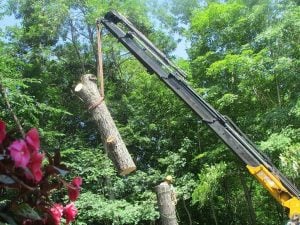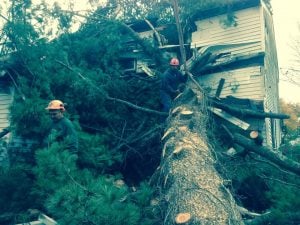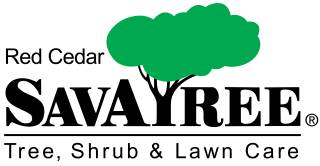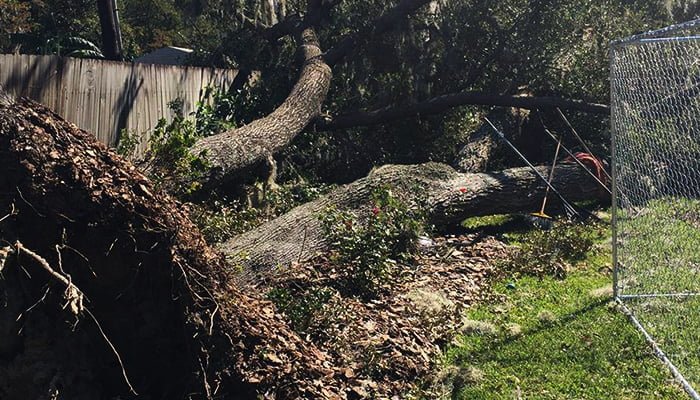It’s no secret that tree work is a dangerous job. Even those that are trained professionals get injured. In fact, in 2016, 153 tree work related accidents were reported, 92 of which were fatal. On average, 5-9 people a month are fatally injured performing tree work. These stats are not meant as a scare tactic, but to shine light on just how dangerous tree work can be, even for those that are trained professionals.
That being said, it is important to not only avoid DIY tree work, but to also hire insured professionals. Did you know that when hiring a worker for a home project that is uninsured and unlicensed you technically become the “employer” or “general contractor”? This means that it then becomes your responsibility to provide worker’s compensation for said worker if any accidents occur on the job on your property. This makes you responsible for medical bills, as well as lost wages from the time off during injury.
Most homeowner’s insurance policies actually state that they exclude damages associated with work from unlicensed contractors. Most commonly, homeowners do DIY projects or higher unlicensed workers to save on costs, but before doing this, consider if the upfront savings is worth the potential cost of damages associated with personal injury, and/or injuries on the unlicensed worker that you are now responsible for.
Not only does tree work take a large amount of skill and knowledge, but it also requires specialized equipment that homeowners likely do not have and/or cannot acquire. In cases where renting or purchasing the required machinery is possible, the cost to do so may be just as much, or more than hiring a professional to do the job.
Here are some common DIY tree trimming dangers:
 Power lines – Downed trees, specifically after a storm, may be leaning against a nearby powerline. Attempting to trim this tree on your own can lead to catastrophic damages as you should never touch a live powerline or anything touching the powerline. Power can travel through the limb of the tree all the way to the ground, which can then electrify the area around the tree as well.
Power lines – Downed trees, specifically after a storm, may be leaning against a nearby powerline. Attempting to trim this tree on your own can lead to catastrophic damages as you should never touch a live powerline or anything touching the powerline. Power can travel through the limb of the tree all the way to the ground, which can then electrify the area around the tree as well.- Heights – Any project involving heights is dangerous. Not only are you dealing with extreme heights when it comes to tree work, but you are also operating heavy and dangerous machinery while doing so. When executing tree removal and/or tree trimming, ladders are not often stable enough and these projects will likely require larger machinery, like a crane or lift.
- Dangerous machinery – The machines used during tree services can be dangerous if not used properly. Did you know that there is an average of 36,000 injuries caused by chainsaw accidents every year? Even if you have experience operating a chainsaw, cutting into a tree can still be challenging. It is not often evident to the untrained eye where a tree holds its tension. That being said, it is common to experience what is called kickback when cutting into the wrong part of a tree, resulting in the chainsaw heading back quickly towards the person doing the cutting.
 Falling trees – It is not always easy to predict where a tree is going to fall given the size and unpredictability. That being said, the tree you cut can end up falling on possessions like your home or car, causing expensive damages. When it comes to tree felling (the process of cutting down an individual tree and dropping it), this is done using very precise cuts to ensure the tree drops safely. Using advanced machinery allows for professional Arborists, like those at Red Cedar, to remove and lift trees to safety in an organized manner.
Falling trees – It is not always easy to predict where a tree is going to fall given the size and unpredictability. That being said, the tree you cut can end up falling on possessions like your home or car, causing expensive damages. When it comes to tree felling (the process of cutting down an individual tree and dropping it), this is done using very precise cuts to ensure the tree drops safely. Using advanced machinery allows for professional Arborists, like those at Red Cedar, to remove and lift trees to safety in an organized manner.
Arborists go through extensive training during their certification process, with safety being a large chunk of that training. At Red Cedar, our Arborists are trained in accordance with OSHA and ANSI and are certified by The International Society of Arborists (ISA). These programs require years of training. Our company has nearly two decades of experience, allowing us to achieve a high level of knowledge and competence in the art and science of tree care. Those that skip the certification stage will likely have a limited knowledge of extensive tree work projects.
Trust in the insured and licensed professionals to not only get your job done right, but to also do it safely. Did you know we also do tree work in the winter? Find out the benefits HERE. Contact Red Cedar today for your free consultation!


